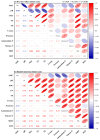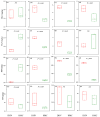Microclimatic Influences on Soil Nitrogen Dynamics and Plant Diversity Across Rocky Desertification Gradients in Southwest China
- PMID: 40284139
- PMCID: PMC12030575
- DOI: 10.3390/plants14081251
Microclimatic Influences on Soil Nitrogen Dynamics and Plant Diversity Across Rocky Desertification Gradients in Southwest China
Abstract
Soil active nitrogen (N) fractions are essential for plant growth and nutrient cycling in terrestrial ecosystems. While previous studies have primarily focused on the impact of vegetation restoration on soil active nitrogen in karst ecosystems, the role of microclimate variation in rocky desertification areas has not been well explored. This study investigates soil active nitrogen fractions and key biotic and abiotic factors across four grades of rocky desertification-non-rocky desertification (NRD), light rocky desertification (LRD), moderate rocky desertification (MRD), and intense rocky desertification (IRD)-within two distinct microclimates: a dry-hot valley and a humid monsoon zone in the karst region of Guizhou Province, China. We evaluate soil organic carbon (SOC), total nitrogen (TN), total phosphorus (TP), soil nitrate nitrogen (NO3--N), ammonium nitrogen (NH4+-N), microbial biomass nitrogen (MBN), soluble organic nitrogen (SON), and plant diversity. Results showed that SOC, TN, and TP were significantly higher in IRD areas. Soil NO3--N, MBN, and SON initially decreased before increasing, with consistent MBN growth in the dry-hot valley. NH4+-N did not differ significantly under NRD but was higher in the dry-hot valley under LRD, MRD, and IRD. The dry-hot valley had higher MBN and SON across most desertification grades. Microclimate significantly influenced soil active N, with higher levels in the dry-hot valley under LRD and MRD conditions. Plant diversity and regeneration varied markedly between the microclimates. In the dry-hot valley, Artemisia dominated herbaceous regeneration, especially in MRD areas. Conversely, the humid monsoon zone showed more diverse regeneration, with Artemisia and Bidens prevalent in MRD and NRD grades. Despite declining plant diversity with desertification, the humid monsoon zone displayed greater resilience. These findings highlight the role of microclimate in influencing soil nitrogen dynamics and plant regeneration across rocky desertification gradients, offering insights for restoration strategies in karst ecosystems.
Keywords: biodiversity; karst ecosystem; microclimate types; rocky desertification; soil active nitrogen.
Conflict of interest statement
The authors declare no conflicts of interest.
Figures




Similar articles
-
The soil properties and their effects on plant diversity in different degrees of rocky desertification.Sci Total Environ. 2020 Sep 20;736:139667. doi: 10.1016/j.scitotenv.2020.139667. Epub 2020 May 23. Sci Total Environ. 2020. PMID: 32485388
-
[Plant and soil nutrient characteristics in the karst shrub ecosystem of southwest Hunan, China].Ying Yong Sheng Tai Xue Bao. 2016 Apr 22;27(4):1015-1023. doi: 10.13287/j.1001-9332.201604.015. Ying Yong Sheng Tai Xue Bao. 2016. PMID: 29732754 Chinese.
-
Effects of rocky desertification on soil bacterial community in alpine grasslands of the Qinghai-Tibet Plateau.Front Microbiol. 2025 Jan 6;15:1485069. doi: 10.3389/fmicb.2024.1485069. eCollection 2024. Front Microbiol. 2025. PMID: 39845040 Free PMC article.
-
Ecological stoichiometric characteristics of soil-moss C, N, and P in restoration stages of karst rocky desertification.PLoS One. 2021 Jun 30;16(6):e0252838. doi: 10.1371/journal.pone.0252838. eCollection 2021. PLoS One. 2021. PMID: 34191821 Free PMC article.
-
The Impact of Artificial Restoration of Alpine Grasslands in the Qilian Mountains on Vegetation, Soil Bacteria, and Soil Fungal Community Diversity.Microorganisms. 2024 Apr 25;12(5):854. doi: 10.3390/microorganisms12050854. Microorganisms. 2024. PMID: 38792684 Free PMC article. Review.
References
-
- Pecl G.T., Araújo M.B., Bell J.D., Blanchard J., Bonebrake T.C., Chen I.-C., Clark T.D., Colwell R.K., Danielsen F., Evengård B., et al. Biodiversity redistribution under climate change: Impacts on ecosystems and human well-being. Science. 2017;355:eaai9214. doi: 10.1126/science.aai9214. - DOI - PubMed
-
- Zheng W., Wu Q., Rao C., Chen X., Wang E., Liang X., Yan W. Characteristics and interactions of soil bacteria, phytocommunity and soil properties in rocky desertification ecosystems of Southwest China. Catena. 2023;220:106731. doi: 10.1016/j.catena.2022.106731. - DOI
-
- Li Z., Xu X., Liu M., Li X., Zhang R., Wang K., Xu C. State-space prediction of spring discharge in a karst catchment in southwest China. J. Hydrol. 2017;549:264–276. doi: 10.1016/j.jhydrol.2017.04.001. - DOI
Grants and funding
LinkOut - more resources
Full Text Sources
Miscellaneous

